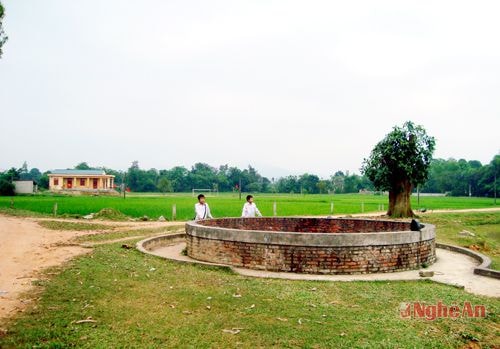Khanh Lac, simple countryside features
(Baonghean) - With Seo Quan mountain range shielding the East, Giai Canh river winding in front, Khanh Lac village, Thanh Ha commune (Thanh Chuong) has always had a simple countryside feel, associated with temple roofs, wells and many humanistic traditions.
 |
| Temple well, Khanh Lac village (Thanh Ha commune, Thanh Chuong). |
The village has 5 small hamlets: Giai Canh, Cho Phuong, Sieu Quan, Dap Boi, and Luong Tri. The hamlets are often clustered on high mounds, surrounded by rice fields. The center of the village is Khanh Lac communal house. The communal house is a 5-room jackfruit wood house with large pillars, located on high land.
After the revolution, the communal house was the place where “popular education” classes were opened and became the village school. The people here still remember the days of land reform, the big communal house pillar was where the horse of the person who brought the “postponement of trial” order from above was tied to the village. Unfortunately, that day, the order did not arrive in time… During the subsidy years, the village communal house was demolished and used as a cooperative warehouse, then as a market house when the commune “married” Rong market. The old communal house no longer exists, but the memories of the familiar communal house still remain with the villagers.
Giai Canh hamlet is a beautiful land, once mentioned in the immortal song of Mr. Cong Ca Nghi, which generations of Khanh Lac people have passed down to each other:
"Tung tung, cac cac, to he"
The mandarin went first, the mandarin went after.
Go then go quickly
Go to Nuong Cau, Nha Vang"
Nuong Cau is the land bordering the village, where there are many revolutionary activists, the French once came to massacre, arrest, and burn down the village. Nha Vang is located in Giai Canh hamlet - the stopping place of the processions every time the village organizes festivals, including drums, gongs, trumpets, flutes, and also respect for the village's "education".
The village has two ancient wells: the well near the Sen temple is called the Sen well; the well near the Dau temple and Giai Canh river is called the Den well. Villagers often gather at the Den well to get water. The old well has a stone bridge, more than 1 meter long, carried on two ironwood poles. Every year, in the 5th and 6th lunar months, the village gathers young men and boys to draw water from the well once. Next to the well is a piece of ancestral land; every year, people are assigned to plow; each time the well is drawn, the plowman must carry 7 kilos of sticky rice and boil 20 duck eggs for the person drawing the well to eat...
The village well existed until the 70s of the last century and after many years of neglect, in 2012 it was restored by the villagers. The well is wide, 6m in diameter, built with blue stone from the bottom up, red bricks on top, with a clean and beautiful floor around it and a banyan tree planted. Restoring the village well, for the people here, is to rekindle the source of the dragon vein; to continue to preserve the meeting place, the exchange of village love; to return to the ancient beauty of the rural landscape.
On Dong Truoc Mountain, hidden behind the ancient trees, is Dau Temple, worshiping Duke Dau Ba Toan (1720 - 1798) - a man with great merit in "protecting the country and bringing peace to the people". The temple faces the Giai Canh River, having undergone many restorations and embellishments... The temple has been conferred many times by the Nguyen Dynasty, and currently still preserves three conferments from the Thanh Thai and Khai Dinh Dynasties. Every year, important ceremonies such as the peace-praying ceremony, the Duke's death anniversary, and the New Year's Eve ceremony are held at the temple.
During its long existence, Dau Temple has been closely associated with the revolutionary struggle of the homeland. In the years 1930-1931, Dau Temple was the place where documents of Thanh Chuong District Party Committee, Vo Liet General Department and Kim Bang Party Cell were kept; it was the place where revolutionary cadres often gathered to discuss plans for the struggle; it was the gathering and training place of the Hoang Xa Self-Defense Force in purging the evil tyrants, taking rice to distribute to the poor; it was the place where popular education classes were organized; it was the place where soldiers were recruited to serve the battlefields...
From ancient times to the present, Dau Temple has been a place for spiritual and cultural activities of the village; a place for people to visit and commemorate; a place to educate the history and traditions of the homeland for many generations. In recent years, the relic management board and local people have made great efforts to restore the temple, gradually restoring the old festival. The People's Committee of Nghe An province recognized Dau Temple as a Historical - Architectural Relic in 2014.
Coming to Khanh Lac, visit Dau temple to commemorate the ancients, go up to Seo Quan peak to see the whole view of fields, gardens, and villages. Giai Canh river has been blocked, but many ancient stories of the village still flow forever. Looking at the bright yellow color of the new village hall, in the middle of the green fields, one can see the rising strength of a countryside.
Huy Thu






